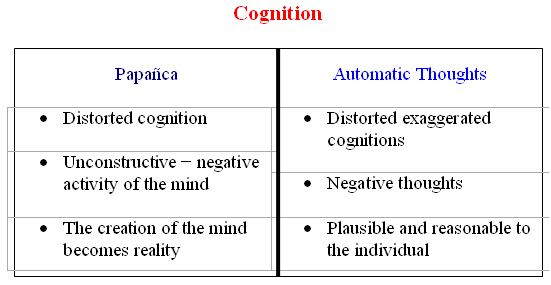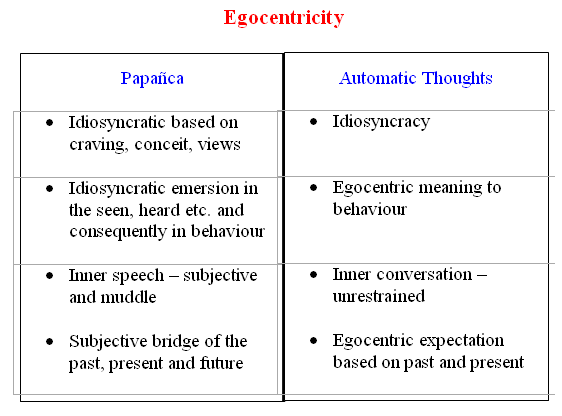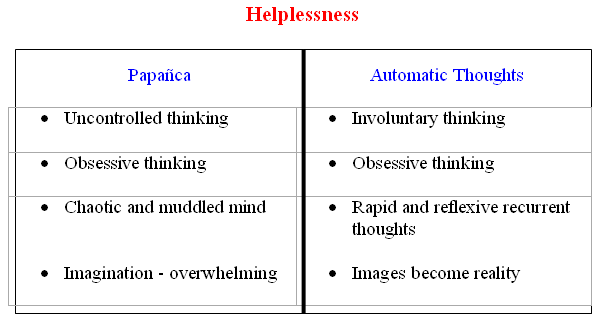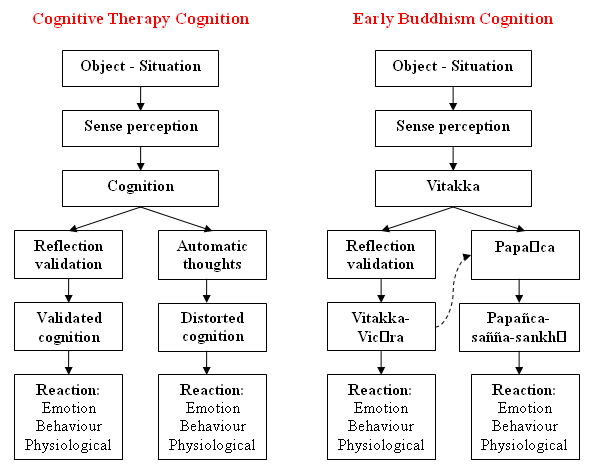‘From Helpless to Selfless’ − the disruptive nature of papa�ca and Automatic Thoughts (Cognitive Therapy) − A Comparison
Aaron Beck met the Dalai Lama in June 2005 in Gˆteborg Convention Centre in Sweden for a dialogue on Buddhism and Cognitive Therapy. In preparation for this meeting, Beck had read some of the writings on Buddhism by Matthieu Ricards, a French Tibetan monk.†† Beck found a great deal of similarity with Cognitive Therapy. Beck does not mention that Buddhism influenced his development of Cognitive Therapy.
In reading Bhikkhu Nananandaís book, ëConcept and Reality in Early Buddhist Thoughtí1, I was struck by the similarities of PapaÒca and Automatic Thoughts. Beck developed Cognitive Therapy in the sixties. He explains and elaborates on what he terms Automatic Thought in his numerous books and articles. The initial impression is that papaÒca and Automatic Thoughts result in dysfunctional and chaotic thinking that lead to exaggerated emotional reactions to experiences and events.
In the final analysis, Buddhism is concerned with how to reduce oneís anguish. It is about human conduct and experiences. It seeks to understand why people think, feel and act the way they do; in that sense the teaching is akin to psychology. This comparisonís significance lies predominantly in the contribution it may make to better understanding the notion of ëwell-beingí. Our study is related to the application of the Buddhaís teaching to every day life and it is written primarily for anyone who is fascinated and perplexed by people and themselves.
Two issues are of particular concern in this study. The first is human engagement with the notion of ëselfí and its concurrent ëegocentricityí. This self is something that most of us subscribe to; the entity that deals with our experiences, thoughts and feelings. Furthermore, the belief that though we change somehow this ëinner selfí remains stable. In a way it is united with our understanding that we exist. Mark Leary in his book, ëThe Curse of the Selfí, asserts that from an evolutionary point of view the self† and the ability to self-reflect seems to be a beneficial adaptation, in the sense that it enables us to think about what we are doing. Yet, he says it is problematic −
ìThe capacity to self reflect distorts our perceptions of the world, leads us to draw inaccurate conclusions about ourselves and other people, and thus promotes us to make bad decisions based on faulty information. The self conjures up a great deal of personal suffering in the form of depression, anxiety, anger, jealousy, and other negative emotions by allowing us to ruminate about the past or imagine what might befall us in the future. The inherently egocentric and egotistical manner in which the self processes information can blind us to our own shortcomings and undermine our relationships with other people. The self also underlies a great deal of social conflict, leading people to dislike those who are different from them, fight with members of other social groups, and perpetrate horrible acts of cruelty.î2
This was addressed extensively in Buddhism: the dangers, the delusion and the anguish in the notion of self.
Papanca is a wider term and is symptomatic of the tendency of the individualís imagination to break all boundaries and create havoc. Buddhism has two other terms for thought process, vittaka and vittaka-vicara. Papa§ca arises from vitakkaí3 (reasoning) that necessitates language. In both cases, the process of conceptualisation is deployed, the issue is that the conceptualisations arrived at differ. Thus, the question is what has been deployed to arrive at such conceptualisation, what it is based on? The answer given will make the difference between papaÒca and vitakka. The question is why this differentiation is crucial? It is important because conceptualisation is the basis of our actual experience, and we live by our experiences. Vittaka-vicara represents the orderly mind and analytical mind while papa–ca is chaotic mind. It should be stressed that there is always the possibility that vitakka-vicara may turn into papa–a.
In this paper we attempt to understand papaÒca and Automatic Thoughts by comparing the two in order to further our understanding of distorted cognition. †Papanca can be understood as ëspreading outí, ëexpansioní, ëdiffusioní and ëmanifoldnessí. Bhikkhu Nanananda refers to it as ëproliferation of conceptsí. We will be using the term papaÒca and hopefully, by the end of the presentation, it will conjure up an understanding that will justify the intended comparison. †
Bhikkhu Nanananda maintains that any conceptualisation necessitates language and can be regarded as sub-vocal speech, as is the case in vitakka-vicaraí. These are verbal functions of the mind and may be called ëinner speechí. In the case of PapaÒca, it becomes ëmuddled inner speechí which overwhelms the individual and makes him lose control over the process ñ he becomes helpless.††
It is important to note that papaÒca is like an affliction to the individual concerns because it caters to our need to predict our future and our surroundings. The Buddha asserts that three psychological states lead to, and result in, papaÒca. Craving, Conceit and Views are the expressed emotions of the deep-rooted tendency of papanca. Buddhism recognises these three psychological states which hinge on the notion of ëIí. They are egocentric psychological states − the ëI-nessí4. Egocentricity enters and becomes central in oneís conceptualisation − papaÒca. This leads to papanca-sanna-sankha; cluttered and unrestrained thoughts that depart from reality. However, it is important to stress that for the individual concerned the creation in the mind is more real then reality. Papanca-sanna-sankha, Bhikkhu Bodhi maintains, seems to refer to perceptions and ideas that have become ëinfectedí by subjective biases, ëelaboratedí by the tendencies of craving, conceit and distorted views. With these subjective biases, papaÒca takes over our thought processes inclining the mind to wrong view characterized by the individualís tendency to †identify oneself †with the object or the situation. The subjective content is appealing and eventually it becomes obsessive and in turn overwhelming. The person becomes helpless in the obsessive grip of papaÒca.
The individual, by making the ëI-nessí an integral part of his sense data, enters the illusion of relationship and ownership, but in real terms he becomes a helpless victim of the spiralling of papaÒca. Buddhism stresses one should guard against superimposing his egocentric desires and thought patterns on any element of the sense data.
The Buddha understood that the individual sees the self as intrinsic to his existence and proceeds to try and locate it in the situation around him. Through methodical examination, the Buddha exposes the implicit inner contradictions of this tendency, thus weakening, challenging and undermining such a distorted perception of reality. The individual is gradually assisted in reaching the understanding that the notion of self is neither sustainable nor plausible. Bhikkhu Bodhi says, ìin this way an unexamined assumption at an earlier stage becomes the basis for a firmly grasped error at a later stageî.
In sum, papanca causes the departure from reality and the present. Understanding papaÒca affords us some insight into the departure from reality led by a digressive process of cognition. It is clear that papaÒca is a cognitive distortion at its inception, but its outcomes are a complex mix of the psychological, emotional and behavioural. It is not confined just to cognition. These powerful needs should be recognised and acknowledged when one tries to understand the potent impact of papaÒca and the sense of helplessness it generates. It is problematic because we identify with the data. In short, the individual gets trapped in a subjective web of concepts through identification, observation and conjectures.
At this point I would like to briefly introduce Aaron T. Beckís Cognitive Therapy and Automatic Thoughts.† Aaron T. Beck developed Cognitive Therapy in the 1960s.† In brief, Cognitive Therapy intends to reduce the clientís emotional distress through the collaboration of the client and therapist in identifying, examining and modifying the distorted and dysfunctional thinking underlying the distress. The premise in the paradigm of Cognitive Therapy is that in order to understand an individualís emotional response we have to understand his subjective views of reality. Therefore, a change in oneís emotional response to experiences should be initiated by a change in the way one conceives it by developing alternative ways of perceiving oneís experiences. The underlying assumption is that there is always an alternative viewpoint and consequently one is free to choose oneís viewpoint. Beck, while practicing psychoanalysis, found that a client omitted to report some thoughts while they were engaged in ëfree associationí.
Through this, Beck realised the substantial impact cognitions have on a personís feelings and behaviour. He concluded that there is an intermediate ideation that leads to emotion that could not be explained solely from the clientís reported free association thoughts. He coined this intermediate association, Automatic Thoughts. He found that there was a correlation between the clientís emotional disturbance and the prominence of the Automatic Thoughts.
Automatic Thoughts areintermediate ideation that the individual is not aware of, but reacts to. They have private meaning and are unlikely to be true because they are not validated. They are important because they precede emotional states. They are involuntary cognitions, in the sense that the individual has no control over initiating or †suppressing them without being trained to be aware of them. They are difficult to inhibit and have dynamism of their own. They are a form of ëinner communicationí or ëinner speechí, often inappropriate to the particular situation that triggered them. There is a discrepancy between reality and cognition. Beck encourages the client to question and analyse their interpretation of the particular situation in order to reduce the subjective nature of their interpretation. Essentially, the Automatic Thoughts are part of a communication system particular to the individual and concentrate on the ëI-nessí. I use the term, ëI-nessí, to signify egocentricity,. It is the tendency to over interpret situations in terms of our own frames of reference, a selective and usually negative interpretation of the behaviour or comments of the other person. Beck says that the typical content of such thought is what Karen Horney termed, ëthe tyranny of the shouldí, when our attention is focused on what we consider others should do and what we consider as our ëshouldí. Discrepancy between the two usually leads to anger, frustration and conflict. The ëtyranny of the shouldí is similar to ídogmatic viewsí in Buddhism.
The individual creates a kind of network system where the ëegocentricityí is pivotal; it provides meaning to his behaviour and that of others, as well as expectations for the future. Each client, according to his emotional disorder, distorts, over generalises, or exaggerates particular situations. Beck 5 ponders ñ
†ëHow can we enable people to recognise and control this automatic mechanism so that they can behave in a more thoughtful and moral way towards each other?í
Automatic Thoughts are specific to the individual. They are egocentric in nature and they are very real for the individual although they do not represent reality.
As reality is the subject matter of both Buddhism and Cognitive Therapy, egocentricity is the pivotal springboard to the subjective and chaotic orientation to reality. In both cases, the results are inappropriate, stressful emotional reactions to oneís experience of the world. In comparing papaÒca and Automatic Thoughts, it is clear that both are expressions of distorted cognition, and consequently, reality. Both deal with conceptualisation gone astray due to egocentricity. The image conjured in oneís mind as a result of perceptual experience does not correspond to ëthings as they really areí which lead to inappropriate reactions or, as Buddhism will coin it, unwholesome states. Both Buddhism and Cognitive Therapy repudiate this departure from reality because it results in anguish (dukkha) and departure from well-being. In both cases the distortion of reality engulfs the individual rendering them helpless. We are induced to think and react to this distorted reality which blocks our ability to perceive reality. This dysfunctional mental activity leads to the loss of control over oneís perception and consequently oneís conceptualisation.
Both papaÒca and Automatic Thoughts lead to an image of a situation or an object which one reacts to with attachment or aversion. When we react to the image with delight and try to hold on to it, it becomes only pleasant and attractive. Conversely, when we develop aversion to the image it may lead to hatred and repulsion. These reactions cloud oneís judgements and ability to understand the nature of things. Buddhism maintains that the tendency to react to our distorted cognition obscures the fact that everything is impermanent, no-self and anguish. Buddhism offers ëDependent Arisingí as the formula for the understanding of causation. The emphasis is on how things come to be; everything comes into being due to causes and conditions, and they are all impermanent, no-self and anguish. This is the nature of reality. Impermanence is the antidote to attachment and aversion. The fact that all conditioned things are in a state of flux is in conflict with our need for permanence and stability. We crave the impossible; we become attached to and desire things, but they are transient resulting in frustration and anguish. For our study it is important to acknowledge that the notion of impermanence makes the possibility of change feasible.
Harris says with regard to language and concepts −
ìThe conventions of language enter near the beginning of the process of sense perception, at the point where feeling gives rise to mental activity and concepts. The mind, if unchecked, will attempt to place order on its feeling through language. This language immediately introduces the duality of subject and object, subject and feeling. The ëIí enters with ëI feel aversioní or ëI feel attractioní or ëI like thisí. This emphasis on the ëIí is predetermined by the very nature of language and reinforces the strength of the feeling and the tendency of the person to identify completely with what is felt. What seems to happen after that is that language takes on dynamism of its own. Concepts proliferate and leave the empirical behind.î6
Buddhism acknowledges the ëIí as a linguistic tool to facilitate interaction with others. We constantly use the word and are deluded to think that it has substance and existence. Conceptualisation of ourselves and the world is done through concepts and images. The usage of ëIí and ëmineí enable us to think about ourselves and interact with others. Buddhism maintains that this usage is part of our everyday life and deludes us to think that there is a substantial entity; we fail to understand that these concepts are tools of conventional use of language. The ëmineí becomes a notion of ownership.† However, if this ownership could be sustained then we should be able to control our body and mind as we would wish. Language misleads us in assuming that our happiness and well-being are based on this entity and its possessions, and we are hoodwinked by our conventional use of language. Language and the use of concepts misinform us of the nature of reality; we tend to overlook the fact that they are only tools. It becomes problematic in particular at the onset of the identity view which sees substance as a lasting self. The conventional ëIí becomes the personal ëIí and in its wake the ëI-nessí arises to replace the conventional linguistic ëIí.
However, Buddhism has afforded us with both the notion of no-self and personal identity. James Gilesí93 7 says in his article, ëThe no-self Theory of Hume, Buddhism and Personal identityí −
ìThere are two levels at which the notion of identity can be employed: one which deals with questions about identity at the metaphysical or ultimate level, and one which deals with them at the verbal or conventional levelÖWe can however, arrive at a fuller understanding of what the two-level account involves by turning to another version of the no-self theory. This is the no-self theory as propounded by the Buddha and several of his followers. The Buddhist theory can offer some insights. For at the very heart of this theory lies the doctrine of the two levels of truth.î
Comparison
In both papaÒca and Automatic Thoughts the problem lies in departure from reality. The person is unaware and helpless in the clutches of this departure because it has the same characteristics as appropriate cognition. Thus one does not see the need to validate this cognition; it is taken as real and one reacts accordingly. Thus, both papaÒca and Automatic Thoughts are destructive because they are an exaggerated reaction to reality that has not been validated. They lead to heightened emotional reactions that are harmful to oneself and others. In both cases, the harm is the distorted conceptualisation; the departure from reality. We react to what Buddhism calls the ëmind-made (manomayam) − cognitionsí. Once we react to these mind-made cognitions − papaÒca and Automatic Thoughts – we are caught in this ërealityí which obscures ëthings as they really areí. The issue at the centre of both Buddhism and Cognitive Therapy is the departure from reality facilitated by Automatic Thoughts and papaÒca.

Both Bhikkhu „Œnananda and Beck refer to papaÒca and Automatic Thoughts as ëegocentric speechí and ëinner speechí.

The comparison of papanca and Automatic Thoughts is made between their major, common characteristics – egocentricity and helplessness. It will be helpful to look into the meaning of egocentricity and how we intend to apply it here. The concept of ëegoí derives from Latin and means ëIí. In a number of philosophical systems, ego is used to denote conscious thinking and non-ego to denote an object. In the psychoanalytic theory the ego is the central feature of personality that fulfils the task of interceding between the superego and the id. The superego is scrutinizing and censoring while the id is the uncounscious part of the mind. This was proposed by Freudís structural model.
Referring to the Oxford Dictionary /
ëegocentric / self-centred, self-absorbed
I will be looking at egocentricity as it is understood by Piaget and Vygosky. Piaget (1886-1980), studied intellectual development in children. He maintains that children tend to have egocentric speech. Children tend to talk out loud to themselves and they are oblivious to others. Piaget describes egocentric speech as,ëthe Language and Thought of the Childí. Piaget depicts egocentric speech as oneís certainty that one is the centre of the universe and everything else revolves around oneself, thus one fails to see the world from other peopleís viewpoint. Piaget argues that this type of cognition is typical of infantile cognition.
This type of speech, Piaget maintains, declines as the child grows older and becomes aware that there are others. The child becomes attuned to the fact that in order to communicate with others he has to take into account their perspectives, whilst earlier the child spoke aloud but addressed no one in particular and did not expect a response from anyone. Piaget says that egocentric speech seems to decline with age and eventually disappears as the childís awareness of his surrounding and his need to communicate with others increases; he becomes more considerate of others and his surroundings.
Lev Vygotsky (1896-1934) was educated as a lawyer and studied literature. He later taught literature and psychology. Vygotsky agrees with Piaget that children are inclined to have egocentric speech, but disagreed with Piaget that this speech declines as the child grows up and develops his social interaction. Vygotsky views egocentric speech as defective social development of the child up to the development of more mature social interaction with others. Vygotsky considers egocentric speech as the forerunner for verbal thinking when speech is turned inward. Furthermore, Vygotsky argues that rather than declining, egocentric speech develops into inner speech.
Thus, Vygotsky argued that inner speech evolves from egocentric speech. He says −
ìEvery function in the childís cultural development appears twice: first, on the social level, and later, on the individual level; first between people, and then inside the child. This applies equally to voluntary attention, logical memory and the formation of conceptsî8
Vygotsky believes that egocentric speech is the transition from the social activity of children to a more individualised activity. Inner speech becomes a speech within oneself and it is a form of linguistic thinking. It leads to complex thinking and concept formation. It becomes the inner regulator of the childís behaviour and takes the same form as social speech which turns inward but is less formulated because a reaction is not expected. Vygotsky sees language as steering and driving thoughts, though he acknowledges that it is rather difficult to investigate. This should not undermine the part it plays in such cognition as problem solving and decision making.
Beck acknowledges Piagetís influence on his formation of egocentricity of Automatic Thoughts. Vygotsky seems to reflect Bhikkhu Nananandaís description of inner speech in papaÒca. In both papaÒca and Automatic Thoughts this inner speech remains egocentric speech in the sense that it is highly inflated with ëI-nessí.

When egocentricity is introduced to the sense data by identifying with it, one is on a slippery slope towards havoc, fantasy and delusion. One loses control and becomes a victim of papaÒca. In both papaÒca and Automatic Thoughts the problem lies in the departure from reality; the person is unaware and helpless in the clutches of this departure.
Cognitive Models

The conceptualisation of reality in papaÒca becomes extensively individualised. This identification introduces a reality and the individual does not see the need for validation. As mentioned before, Beck says that this is due to the fact that the underlying characteristics of appropriate and inappropriate cognition are the same. Cognition has important characteristics −
- Experience is considered from the perspective of time such as present, past and future
- The individual habitually considers cognitions as accurate depictions of his surrounding world; they are believed to be true.
Furthermore, Beck9 maintains that some of the psychopathological manifestations of emotional disorders are inflated forms of ënormal-appropriateí emotional reactions. He terms this, ëthe continuity hypothesisí. maintaining that there is continuity between the content of ënormal-appropriateí reactions and the over responding seen in psychopathology. The above explains why the distorted cognition in both papaÒca and Automatic Thoughts seem to be reliable cognitions making validation unnecessary. Finally, the Buddhaís teaching and Cognitive Therapy accept that a personís reliance on egocentric views of his experiences ends in personal pain and social conflicts. Thus, a change is required. Buddhism is mistakenly considered to be pessimistic because of its emphasis on anguish (suffering). Buddha in his first sermon outlines not only dukkha but also the cure, the Eightfold Path; the ability and the need to reach Right Understanding and Right Thought. The possibility of change is a fundamental feature of the Buddhist world view.† Beckís theoretical perspective is that people can change, furthermore, they have responsibility to change and will change. The ability to change is rooted in the pursuit of well being.
Endnotes
2 Leary, M.R. (2004) ëThe Curse Of The Self, self-awareness, egotism and the quality of human lifeí Oxford University Press p.21
3 Rhys Davids renders vitakka ëreflection, thought, thinking; ëinitial applicationí. Rhys, T.W. Davids & Stede, W. ìPali English Dictionaryí Oxford
4 This term was uses by Peter Harvey book ëThe Selfless Mind. Personality, Consciousness and Nirvana in Early Buddhismí (1995) Curzon Press
5 Beck, A.T. (1999,2000) ëPrisoners of Hate ñ the Cognitive basis of Anger, Hostility, and Violenceí Perennial-Harper Collins p.†
6 Harris, E. (1990) ëViolence and Disruption in Society: A Study of the Early Buddhism Textsí BPS, Kandy (Buddhist Psychology Vietnamese Section Quang Duc, p.22)
7 Giles, J (April 1993) ëThe No-Self Theory Hume, Buddhism, and† Personal Identityí Philosophy East and West, Volume 43, Number 2 p.184-185


